Ontario is the second-largest province in Canada in terms of size, boasting a diverse range of weather extremes. This scenic territory borders the Great Lakes and experiences a continental climate, characterized by warm to humid summers and cold, chilly winters.

These varying conditions encourage the growth of a variety of weeds, including persistent annuals and perennial grasses, that can be found in gardens, lawns, open areas, and disturbed sites.
This post covers 20 common weeds you’ll come across in Ontario’s subregions, including their scientific names and accompanying pictures to aid in identification. We’ll also explain the best removal methods to ensure they don’t take over your outdoor spaces.
1. Lamb’s Quarter (Chenopodium berlandieri)

- Local Name: White Goosefoot or Common Lambsquarter
- Family: Amaranthaceae
- Annual or Perennial: Annual
Lamb’s Quarter is a summer annual that grows up to 1.8 m. It is native to Europe and Asia, but it is widely spread in many parts of Ontario. The summer annual thrives in gardens and near streams and rivers. It is also a common weed in crop lands, including soybeans and sugar beets.
You can remove the weeds through hand weeding, mowing, tillage (dark tillage), or crop rotation, depending on the area of infestation.
2. White Clover (Trifolium repens)
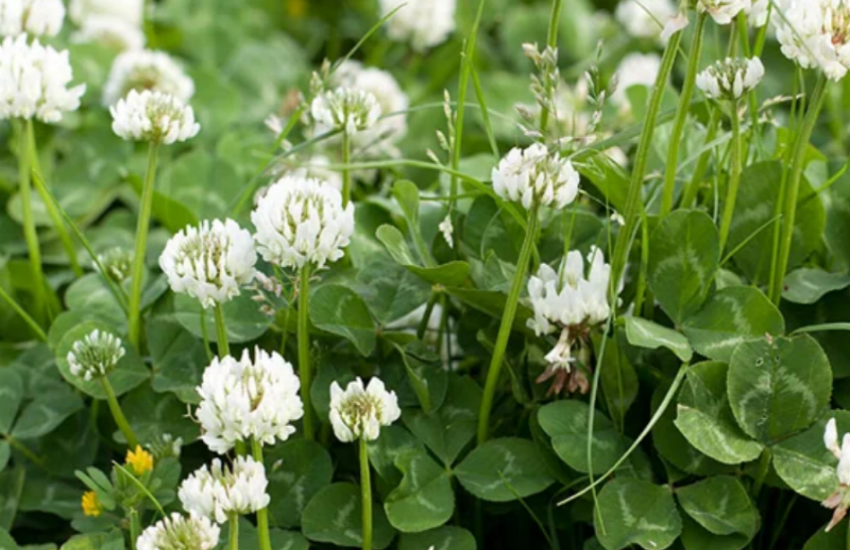
- Local Name: White Clover
- Family: Fabaceae
- Annual or Perennial: Perennial
White Clover is a perennial plant that lives about 2-3 years. It is native to Europe and Asia and can be identified by its trifoliate leaves and whitish florets. While it is widely grown as a forage crop in Ontario, it can also become a persistent weed in gardens and lawns.
Hand weeding is a viable removal option in garden beds where infestations are small. When white clover grows on a lawn, it may require more strategic interventions, like increasing nitrogen fertilization to attain healthy and vigorous grass that can outcompete white clover.
3. Canada Thistle (Cirsium arvense)

- Local Name: Creeping Thistle, Cursed Thistle, Field Thistle, or California Thistle
- Family: Asteraceae
- Annual or Perennial: Perennial
Canada Thistle is a perennial weed that grows up to 1.5 m tall. You can easily identify it by its glossy green leaves with spiny edges, smooth, spineless stem, and small clusters of pink to purple flowers on the ends of the branched stems.
It is one of the most aggressive weeds in Ontario, and its rapid spread can make eradication efforts difficult. Canada thistle invades grasslands, roadsides, crop fields, and lawns. Repeated mowing or cutting them off at ground level before they seed can help limit the spread of the weed.
4. Large Crabgrass (Digitaria sanguinalis)

- Local Name: Crabgrass, Hairy Crabgrass, or Crab Finger Grass
- Family: Poaceae
- Annual or Perennial: Annual
Large Crabgrass is a common weed in Ontario’s lawns and cultivated fields. While it is a late bloomer, it can weaken even the most manicured turf and overtake large areas through its efficient regeneration. It has also been reported to cause significant and cause yield losses in soybean and corn fields.
Grow a vigorous and well-watered lawn to discourage crabgrass growth. You can also pull out the patches of grass to get rid of the entire rhizome system.
5. Japanese Knotweed (Fallopia japonica)
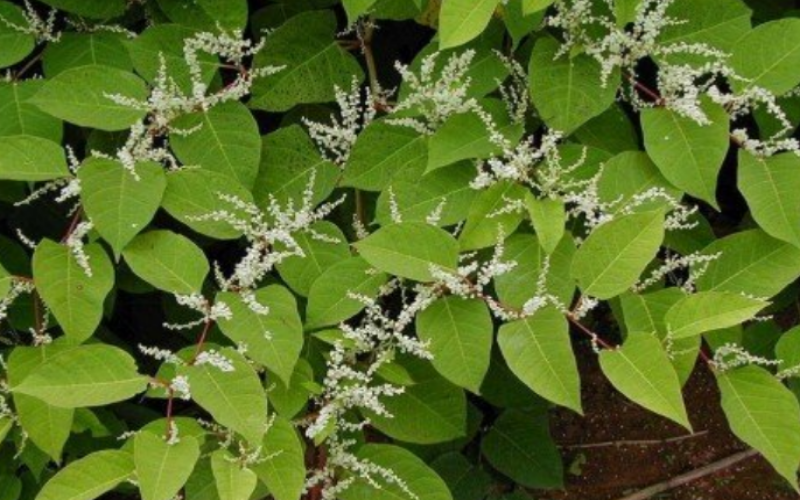
- Local Name: Japanese Knotweed
- Family: Polygonaceae
- Annual or Perennial: Perennial
Japanese Knotweed is a perennial weed easily identified by its broad leaves and creamy white flowers. It is mostly found in the southern and central areas of the province along roadsides, in farmlands, and gardens.
Grazing, mowing, and other natural methods can help eradicate Japanese Knotweed.
6. Creeping Charlie (Glechoma hederacea)
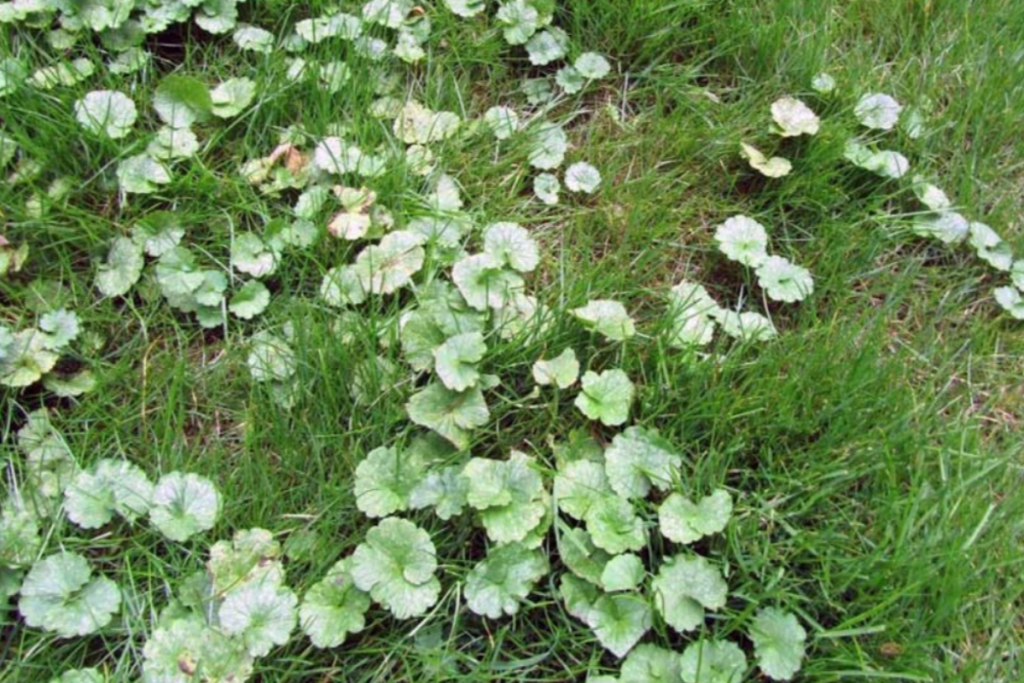
- Local Name: Creeping Charlie
- Family: Lamicaeae
- Annual or Perennial: Perennial
Creeping Charlie is a perennial weed, native to Europe and Asia, but now found throughout Ontario. The weed has dark green leaves with serrated edges and small bluish flowers. Its high seed production and ability to propagate vegetatively make it a persistent weed in many subregions.
To remove Creeping Charlie, try hand-pulling for small infestations and herbicides like Fiesta for larger areas.
7. Field Bindweed (Convolvulvus arvensis)

- Local Name: Field Bindweed
- Family: Convolvulceae
- Annual or Perennial: Perennial
Field Bindweed is an Eurasian native that can be a creeping or climbing plant about 0.5-2 m long. It can be found throughout Ontario but is commonly associated with the southwestern region in open fields, crop farms, and waste areas.
You can pull out small patches of the weed by hand or apply natural methods like solarization and boiling water.
8. Common Purslane (Portulaca oleracea)
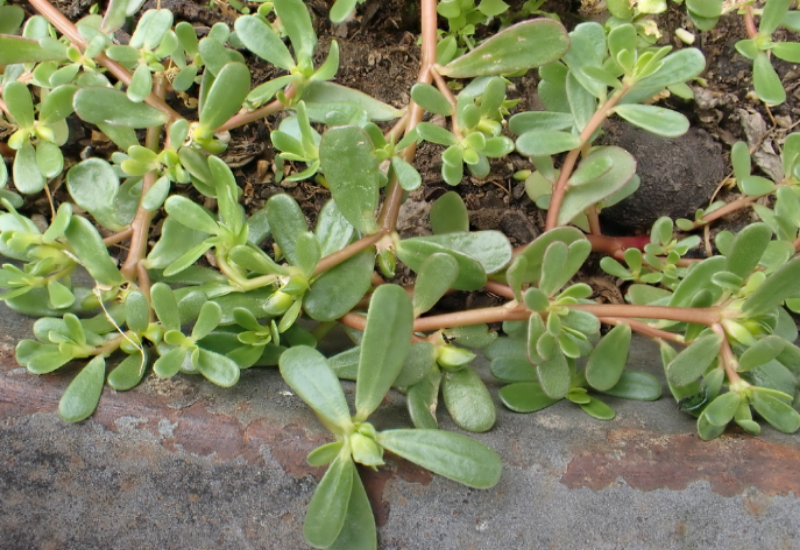
- Local Name: Purslane or Little Hogweed
- Family: Portulacaceae
- Annual or Perennial: Annual
Purslane is a common weed noted for its reddish stems, entire leaves, and dense mats. It is a native of Southern Europe and Northern Africa.
The short succulent is a prolific seed producer and quick-spreading, making it a notorious weed of lawns, vegetable gardens, open fields, and cultivated lands.
Mulching and solarization can effectively kill the purslane and its seeds.
9. Creeping Speedwell (Veronica filiformis)
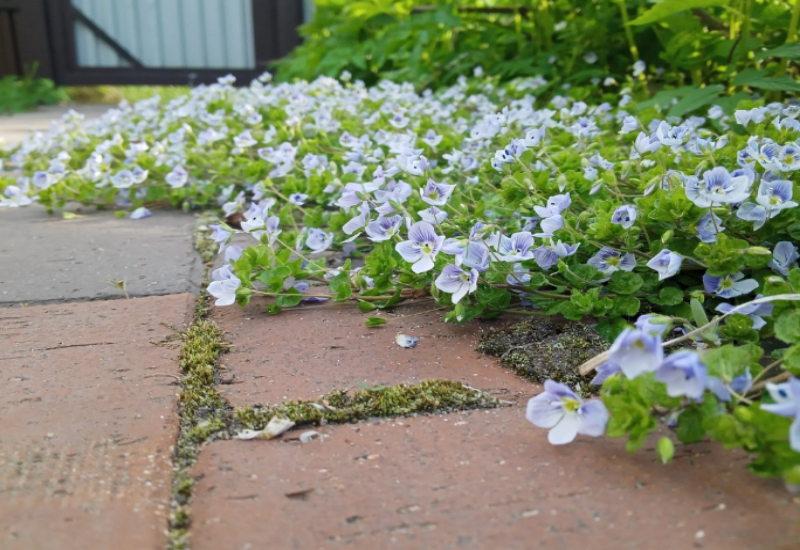
- Local Name: Creeping Speedwell or Hairlike Speedwell
- Family: Plantaginaceae
- Annual or Perennial: Perennial
Creeping Speedwell is a low-growing weed, native to western Asia and eastern Europe. It has rounded or kidney-shaped leaves at the base of the stem and 4-petaled blue flowers. The weed spreads by nodding on the stems and rhizomes, spreading on gardens, lawns, and sidewalk cracks.
Pull out the young plants and ensure to properly dispose of the stem and rhizome fragments to prevent regrowth. Iron-based herbicides can also provide effective control against Creeping Speedwell.
10. Dandelion (Taraxacum officinale)

- Local Name: Dandelion
- Family: Asteraceae
- Annual or Perennial: Perennial
Dandelion is a common weed across Ontario’s cultivated fields, lawns, roadsides, and other disturbed sites. The Eurasian native is easily identified by its deeply toothed leaves and showy, yellow flowers.
Pull solitary weeds while young and ensure to remove the taproot. Digging tools can provide better results when removing the plants and their roots as they grow in spring.
11. Canada Fleabane (Erigeron canadensis)
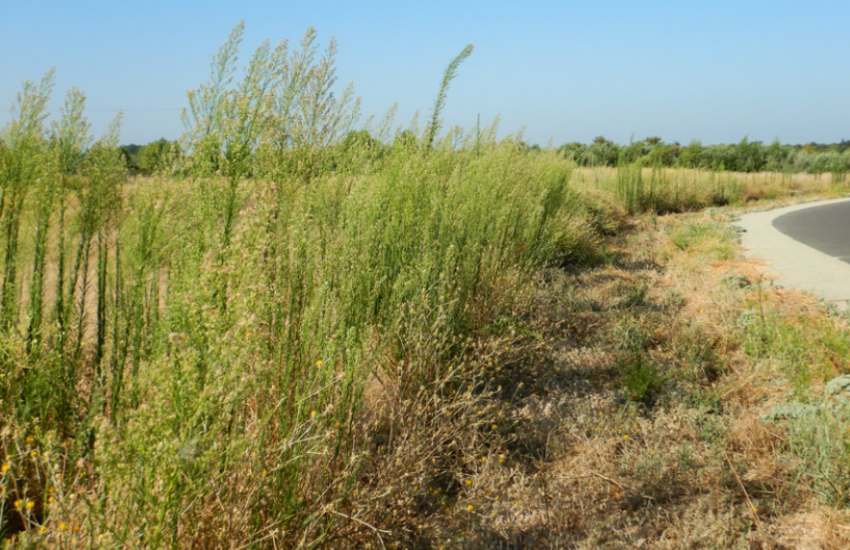
- Local Name: Fleabane or Horseweed
- Family: Asteraceae
- Annual or Perennial: Annual
Canada fleabane is an annual herbaceous plant 1.5 m tall. It has slender, long, and hairy leaves and much-branched, small, white flowers.
Fleabane is a common weed in Ontario, especially in gardens, pastures, and roadsides. It is a noxious weed in crop fields, causing as high as 90% yield losses in soybean plantations.
Since it has a taproot, you can remove it by pulling or hoeing. Mowing, tillage, or applying iron-based herbicides in spring or fall can also reduce seed production, dispersion, and growth.
12. Bermudagrass (Cynodon dactylon)
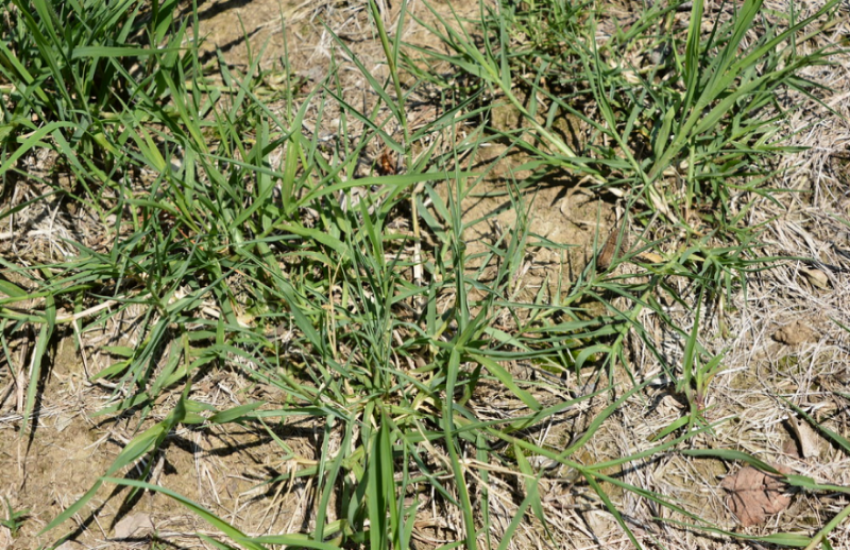
- Local Name: Bermudagrass
- Family: Poaceae
- Annual or Perennial: Perennial
Bermudagrass is a warm-season grass about 30 cm tall. This resilient grass can grow in all types of soils and weather conditions, has a deep root system, and also spreads through rhizomes. The grass invades lawns, fields, roadsides, row crop farms, and other disturbed areas, mostly in the warmer southwestern Ontario.
Repeated digging of the grass and pulling out the root fragments is the most common way to remove the grass. Mulching and solarization can also work for flat areas.
13. Shepherd’s Purse (Capsella bursa-pastoris)

- Local Name: Shepherd’s Heart, Pick Purse, Poverty Weed, or Beggar’s Tick
- Family: Brassicaceae
- Annual or Perennial: Annual
Shepherd’s Purse is an annual weed that grows 50-70 cm tall, native to Europe and Asia. You can identify it by its hairy, rounded to oval leaves and small white-petaled flowers.
In Ontario, it is found in gardens, fields, roadsides, waste areas, and can also be found in winter cereals.
You can remove the weeds by hand-pulling, hoeing, mulching, or crop rotation to make it difficult for the weeds to establish and spread.
14. Quackgrass (Elymus repens)

- Local Name: Quitch Grass, Couch Grass, Twitch Grass, or Scutch Grass
- Family: Poaceae
- Annual or Perennial: Perennial
Quackgrass is a perennial weed (30-120 cm tall) that’s native to Europe and temperate Asia. It has flat, linear leaves about 15-40 cm long and pale-greenish wheat-like spikelets.
Scutch grass is a problematic weed in lawns, grasslands, and agricultural settings where it not only competes for important resources but also causes poor harvesting when it gets entangled in the crops.
Whether you want to remove quackgrass from your lawn or crop field, strategies like cultivation, crop competition (planting crops at optimal depth) can prove effective.
15. Common Ragweed (Ambrosia artemisiifolia)

- Local Name: Short Ragweed
- Family: Asteraceae
- Annual or Perennial: Annual
Common Ragweed is a native of Central and Northern America, including Ontario, particularly in the southern part of the province. The summer annual can grow up to 1.5 m tall. Its leaves have a fernlike appearance and can produce small yellowish brown flowers.
It is a serious weed of riverbanks, grasslands, and agricultural fields, where it causes catastrophic losses by contaminating harvested produce.
Remove annual ragweed by hand weeding, mechanical cutting, mowing, or planting red clover as a cover crop. Other removal methods include applying essential oils from clove, cinnamon, and red thyme.
16. Broadleaf Plantain (Plantago major)

- Local Name: Plantain, Common Plantain, Dooryard Plantain, or Doorweed
- Family: Plantaginaceae
- Annual or Perennial: Perennial
Plantain is a broadleaf weed, native to Europe and Asia, but now also commonly found throughout Ontario. As the name implies, it has broad leaves that grow from a basal rosette and produces inconspicuous, small white flowers.
This resilient weed can withstand foot traffic, water-logging, and compaction, hence its prevalence in open fields, pastures, cropping systems, sports fields, lawns, and waste areas.
For smaller areas, remove the young plants before they seed and monitor to ensure there is no regrowth.
Hand-pulling or placing a 2-4 inch deep organic mulch in ornamental plantings can prevent seedling growth. For larger infestations, apply a herbicide like Fiesta for effective control.
17. Hairy Nightshade (Solanum physalifolium)
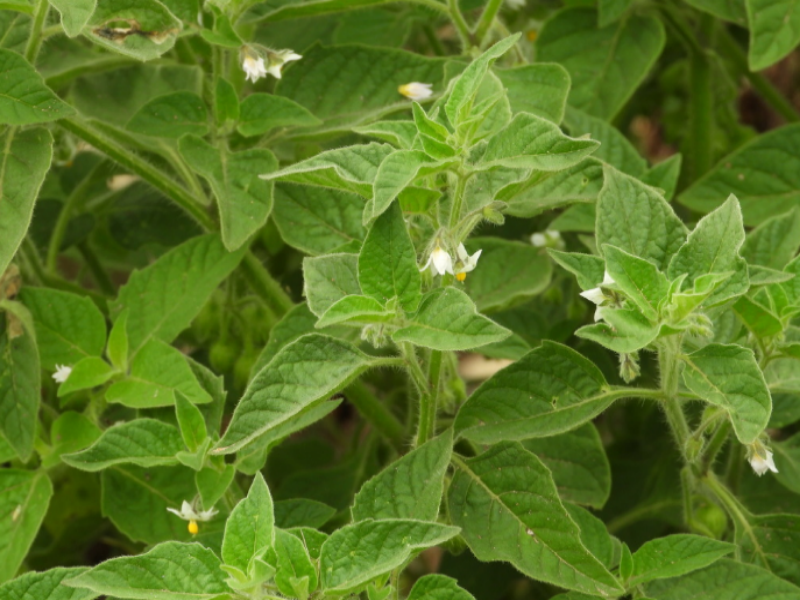
- Local Name: Potatoweed or Brown-berried nightshade
- Family: Solanaceae
- Annual or Perennial: Annual
Hairy nightshade is a South American native annual that can be identified by its almost sticky stems and ovoid to deltoid leaves and small clusters of star-shaped, white-petaled flowers.
It is a weed of pastures, crop fields, orchards, vineyards, roadsides, and other disturbed sites. Hairy nightshade not only competes for resources but also hosts several pests and diseases, clogs crop field machinery, and can be toxic to humans and livestock.
Solarization and repeated tillage are effective against the weed, depending on the area and crop affected.
18. Green Foxtail (Setaria viridis)

- Local Name: Millet, Brush Millet, Bottle Brush, or Bottle Grass
- Family: Poaceae
- Annual or Perennial: Annual
A Eurasian native, Green Foxtail is a tall weed that can reach 1- 2 meters or more. It has long, glabrous leaves and an erect or nodding 20 cm long, compact spike-like panicle.
The weed is one of the first grasses to emerge in spring, typically after the broadleaf weeds. Green foxtail can be found in gardens, cultivated fields, and roadsides throughout Ontario.
Use a trowel to pull out the weeds from the lawn. Improving turf management through proper irrigation and fertilization can also discourage weed growth.
19. Mouse Ear Chickweed (Cerastium fontanum)
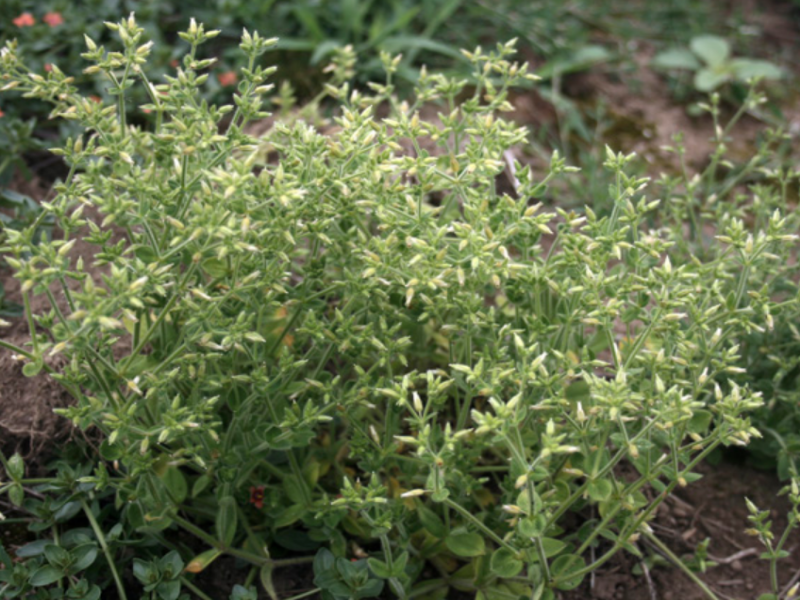
- Local Name: Mouse Ear or Large Mouse Ear Chickweed
- Family: Caryophyllaceae
- Annual or Perennial: Annual
Mouse Ear Chickweed is an annual weed that nodes on the stems, forming large and dense low-growing patches. You can identify the weed by its small, oval leaves with entire margins, hairy, reddish-brown stems, and white, deeply notched flowers.
This weed can be located in a range of habitats throughout Ontario, including lawns and cultivated fields.
Pull or dig them out before they flower if spreading in a garden, and ensure to remove all the fragments to avoid resprouting.
20. Garlic Mustard ( (Alliaria petiolata)

- Local Name: Garlic Mustard
- Family: Brassicaceae
- Annual or Perennial: Biennial
Garlic Mustard is a native of Europe and Asia that was introduced in North America as an edible herb. Today, this tall plant has become one of the top forest invaders in Ontario.
It has been reported to displace native plants like the Trout Lily (Erythronium americanum) and threaten other species like Wood Poppy (Stylophorum diphyllum) and White Wood Aster (Eurybia divaricata).
Apart from the forests, Garlic Mustard can also be found along trails and roadsides.
Pull the weeds by hand for small or isolated infestations and dispose of them properly. Prescribed burning or a Fiesta application on actively growing foliage can control medium to large infestations.

Lead Editor for Insight Weeds.